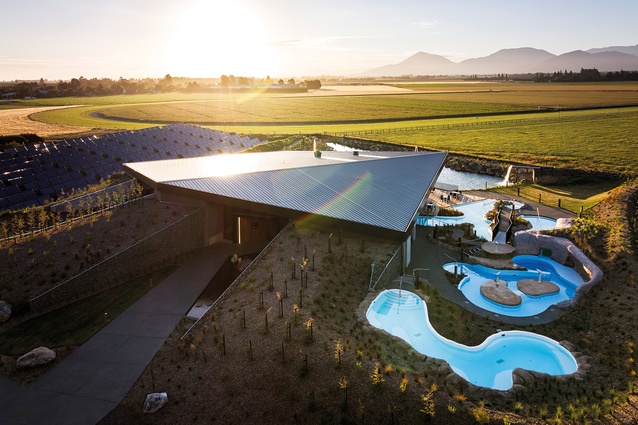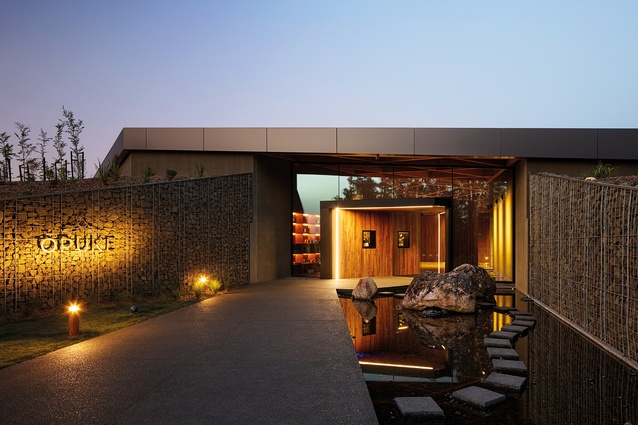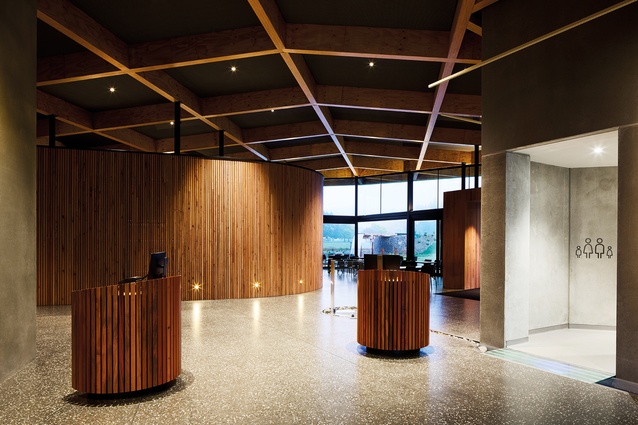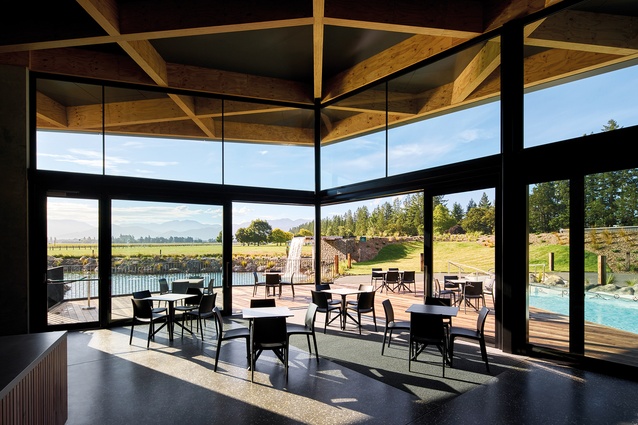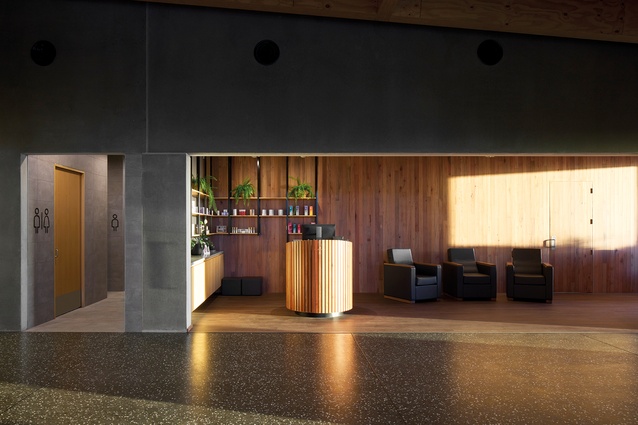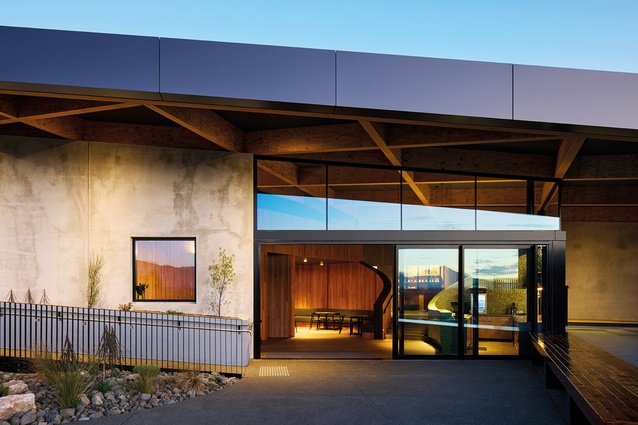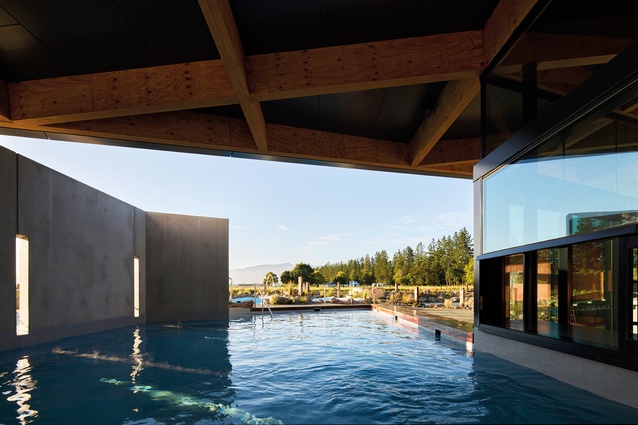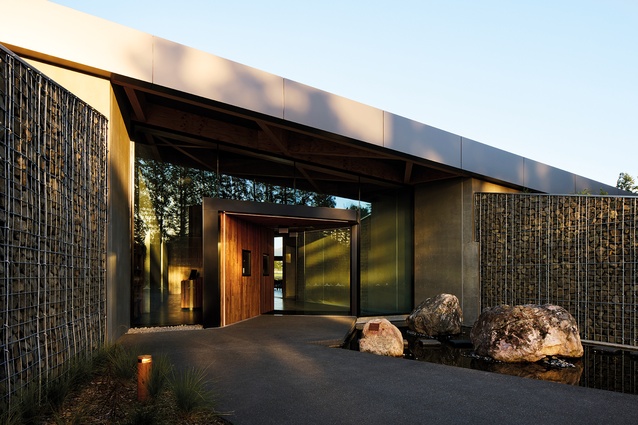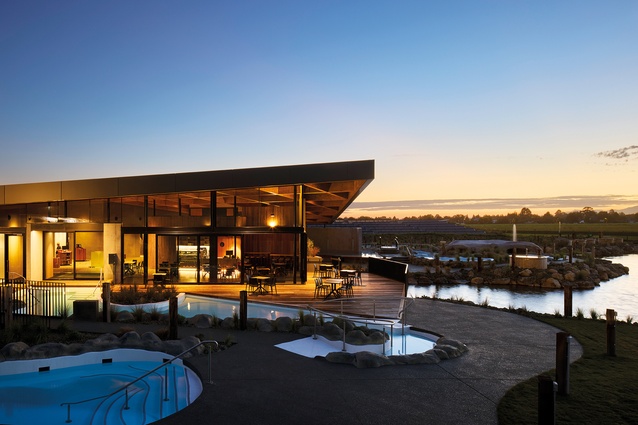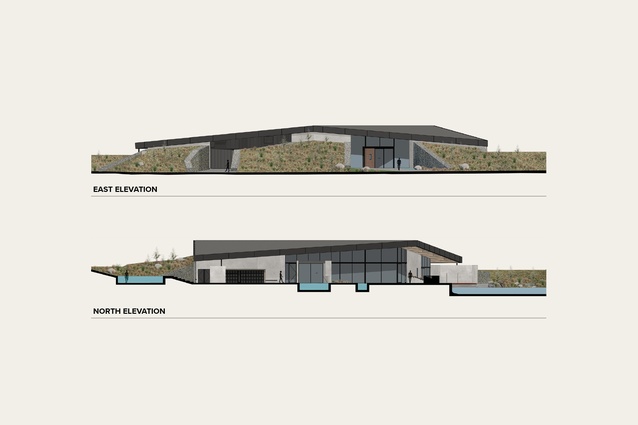Solar gain
Matthew Webby soaks in the sun, the water and the sustainability of Ōpuke Thermal Pools and Spa by Sheppard & Rout Architects.
Water has always been integral to the inhabitation and development of Canterbury’s flat alluvial plains. The braided river systems weaving their ways from Kā Tiritiri o te Moana, the Southern Alps, across to the Pacific coast were mana whenua’s highways providing passage to mountain passes and the West Coast beyond. These vast plains, built up by the rivers over millions of years, have undergone significant modification during the past two centuries as water resources have been tapped into to create a productive patchwork of fields. More recently, pivot irrigation has extended the water’s reach, further greening the land to support the region’s now billion-dollar dairy industry.
The Ōpuke Thermal Pools and Spa on the outskirts of Methven is a small but meaningful diversification of both the mid-Canterbury economy and of our valuable but finite water resource. Sited near the Rakaia River and under the shadow of the mountains and Mt Hutt ski area, the pools, like the farmland around, are recipients of water from the 67km-long Rangitata diversion race.
Marketed as “… a unique experience where you can relax while soaking in the Southern alpine views”, the pools are located on a seemingly less-than-idyllic site: a former field on the periphery of Methven’s racecourse. These client aspirations have been adeptly handled and translated into an inviting new destination by Sheppard & Rout Architects (SRA) and team.

On arrival, after journeying across the flat agrarian landscape of the Inland Scenic Route 72 or via Methven township, you slip through a gap in the roadside shelterbelt pines and are greeted by an unexpectedly hilly terrain plastered with solar collectors and the folded roof plate of the pool complex.
Here, your transportation off the flat plains begins. Project lead Matt Gutsell describes SRA’s concept for the pools as being one of a journey that takes you from the plains into the mountains where hot pools are naturally found. Thanks to much heavy machinery, the alluvial gravels have been extensively sculpted to create a somewhat Disney-fied landscape of mountains and hot pools with the real mountains sitting as a picturesque backdrop beyond. The scale and arrangement of solar collectors surrounding this set-up appear reminiscent of a renewable energy scheme but are, in fact, dedicated to harnessing the sun’s heat for the thermal pools. Director Jasper van der Lingen (SRA) notes that this prominence was deliberate and desired by the client as they sought to announce their sustainability credentials. Although not fully perceivable on the ground, the site plan reveals that a significant portion of the site — and, no doubt, comparative investment — is given over to this strategy for heat generation. While this is a technological marvel and a first for the country, this overt technological display is fortunately left at the car park as you make for the entrance.
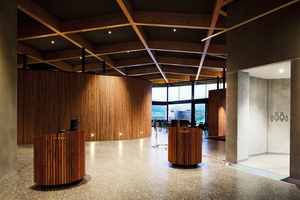
At the entry court, you are greeted by the calming presence of running water flanked by gabion walls concealing the bulk of the building behind. SRA’s conceptual driver for this space of a river gorge is carried through into the building interior, with running water extending through to reception and check-in. SRA’s perseverance in arguing the compliance of an open water channel through a public foyer is commendable and is, undoubtedly, what underpins the sensory experience of this space. The gorge walls — now formed by raw, pre-cast concrete — begin to open up, revealing a series of pods enveloping the more private functions, while the more-open circulation spaces flow around these volumes. Hovering overhead is the singular design move that frames and defines the building: a gridded timber structure forming a large-scale coffered ceiling.
The generous reception space sits between three pods: two concrete containing changing facilities and a third clad in timber and containing the kitchen and café. The vistas to the pools and mountains beyond are hinted at but this space is more about being contained than observing. In plan, the building is structured around three axes meeting in the centre with space generously allocated to each of these. The reality is that only the entrance axis is really circulated along, as, from reception, visitors peel off to one of two sides to either the family-friendly changing rooms leading to the ‘Discovery Pools’ or the adult-only changing facilities for accessing the ‘Tranquility Pools’. Those in need of extra pampering can also head further on into the specialist day spa facilities.
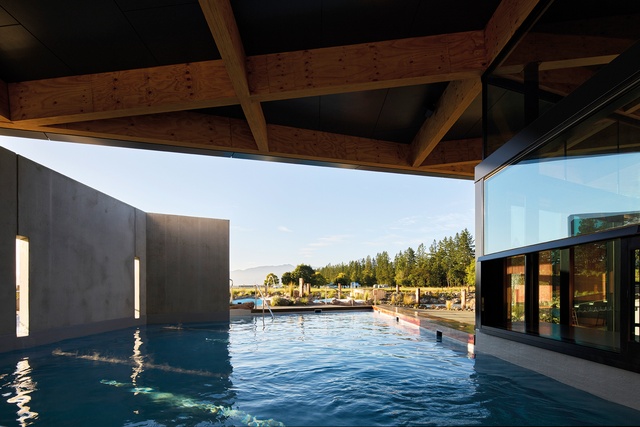
Once changed, you move out to the pools. For those in the Discovery area, this is a direct and abrupt transition where you are immediately deposited poolside by a series of connected pools. In keeping with its namesake, the interior and exterior are nicely blurred as you are calmly guided to the Tranquility Pools. From the changing area, you flow around the curvaceous bar that serves directly to both the pool and the internal bar lounge. Despite a generous internal seating area, few appear to be tempted away from the allure of the pools — or perhaps there is too much potential for a togs-togs-undies moment for the uninitiated. With some creative solutions to liquor licensing requirements, the bar serves direct to the pools, meaning you can be fed and watered, all while soaking in the delights of 38.5°C water. Adding to the sense of comfort, the solid pre-cast walls extend out from the building into the pools, sheltering your experience, while the gridded timber roof structure extends generously over the first pool, offering relief from the sun in summer and from the elements in winter. Once established, native planting will further transform this setting and fully erase the fact that you are soaking on the edge of a racecourse.
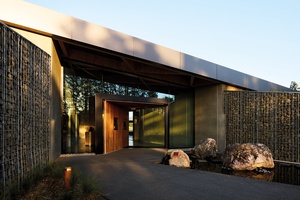
The timber structure employed by SRA and structural engineers Ruamoko echoes that of many New Zealand pool buildings which take advantage of the corrosion-resistant properties of glue-laminated timber. The material warmth offered by the timber roof structure at Ōpuke is critical to the success of what is otherwise an undeniably concrete building. In lieu of glulam, laminated veneer lumber (LVL) has been used, including within the building’s generous external eaves and over the external pool bar. This selection is presumably driven from a structural and economic perspective but, given LVL’s limited treatment and despite its careful positioning and detailing, it is a brave choice externally in this wet environment.
Underlying the selection of a timber roof structure is, of course, its sustainable credentials. Sustainability is integral to the brand of the Ōpuke Thermal Pools and Spa and its use of renewable energy to heat the pools will minimise its operational carbon over years to come. Despite the use of a timber roof structure, however, it’s safe to assume that the development itself has a high volume of embodied carbon. This is not a criticism but acknowledges that steps towards a sustainable future are incremental not fundamental.
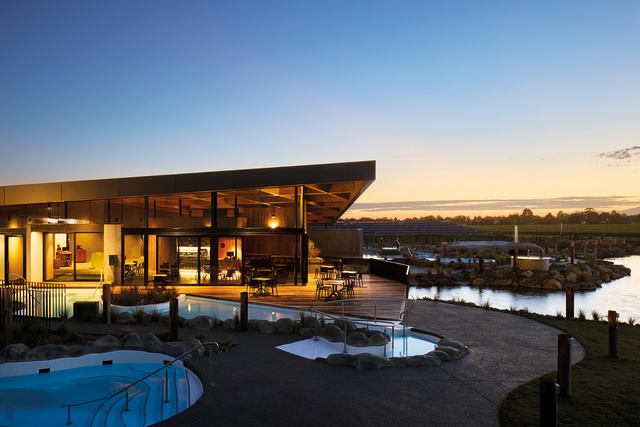
It was a bold move to set out to create thermal pools heated by the sun and Jasper van der Lingen recalled that, at the time, the idea certainly had its doubters. This type of challenge to the status quo is, however, what we need to occur in order to transform the ways in which we develop. The calculated risk was no doubt tempered by $7.5 million of loan funding from the Provincial Growth Fund providing around 40 per cent of construction and establishment costs.1 Detractors of the scheme argue the Government shouldn’t be providing favourable lending to commercial enterprises but Ōpuke provides an example of Government facilitating pioneers to test new ideas.
Sustainability is not about just carbon and energy but, of course, about people and the environment; the complex is a hive of activity. The pools themselves are operated by a small army of staff, mostly local, while the adjacent town of Methven is already receiving the flow-on effect of increased visitors, including outside the ski season.
Through the creation of the Ōpuke Thermal Pools and Spa, Sheppard & Rout Architects and the team have transformed an unassuming field into a destination that supports its local community, considers its environmental impact and treats water as the taonga that it is.
References
1. rnz.co.nz/news/ldr/479547/thermal-poolcomplex-opukecelebrates-achallenging-butsuccessful-firstyear

